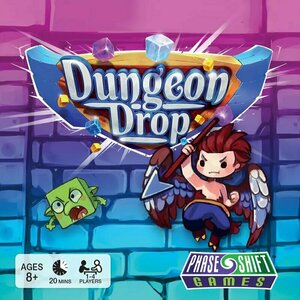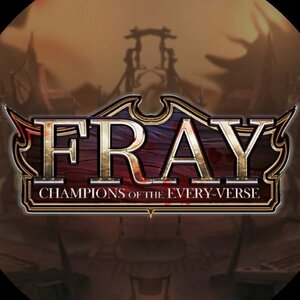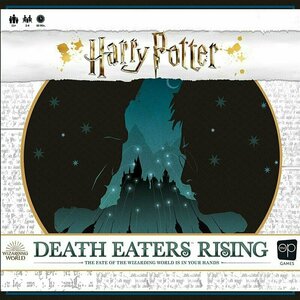
Totally Wired: The Wild Rise and Crazy Fall of the First Dotcom Dream
Book
On the morning of Monday, April 3, 2000, Josh Harris woke to the knowledge that he was about to lose...

Lord of the Darkwood (Tale of Shikanoko #3)
Book
Shikanoko, at what should be a warrior's hour of greatest triumph, turns his back on those around...
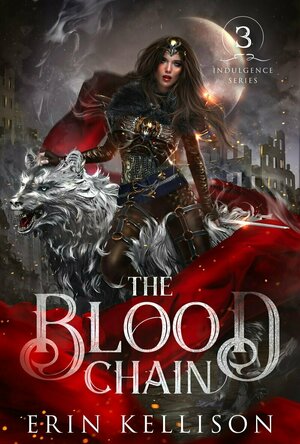
The Blood Chain (Indulgence #3)
Book
Erin Kellison's Indulgence World is on fire with heart-stopping romance, perilous adventure, and...
Fantasy Romance
Purple Phoenix Games (2266 KP) rated Dungeon Drop in Tabletop Games
Feb 15, 2022
Dungeon Drop is a game of set collection, area enclosure, and dexterity (to a degree) in which players take on the roles of dungeon-delving adventurers trying to gather treasure, defeat monsters, and complete quests. To setup for a game, each player is randomly dealt a Race card and a Class card – each with a special ability for use during the game. Turn Order tokens are distributed based on the Initiative on your Race card, starting with the lowest number. All players are dealt a Quest card that will dictate some end-game scoring for the player, and Quests are kept secret from opponents. Now it’s time to setup the dungeon. Separate all the Small cubes from the Larger ones – purely based on size, the color of the cube does not matter. All the Larger cubes are placed into the game box, for use later. The starting player will gather all of the Small cubes (plus the giant Dragon cube) and literally drop them onto the center of the table. The rulebook suggests dropping the cubes from a height of 6-12 inches, to ensure the cubes spread evenly across the table. And bam – there’s your dungeon.
The game is played over 3 rounds during which each player will take a turn. Turns are broken down into 3 steps: Explore, Act, and Loot. To Explore, the active player will take a set number of the Larger cubes from the game box (at random, without looking), and will add them to the dungeon by dropping them onto the table. The next step is to Act. Each Race and Class card has a special ability, and during this step you will choose to activate one of those abilities to use this turn. The final step is Loot, and this is where the crux of the gameplay is. The cubes of the dungeon consist of Treasure cubes, Monster cubes, and Pillar cubes. Pillar cubes are what form the ‘rooms’ of the dungeon. When it is your time to Loot, you will form a room by selecting 3 Pillar cubes. These cubes will essentially form a triangle, and the inside area of that triangle represents the room in which you are in. Once you form a room, you will collect all cubes from within that space – whether they be Treasure or Monster cubes. Treasure cubes go into your Stash and are saved for end-game scoring, and Monster cubes will deal Damage to your Hero. All Heroes have a finite amount of Health, and you can never collect a Monster cube that would cause you to lose your last Health point.
When you are done Looting, flip over your Turn Order token to indicate that your turn is done. When all players have completed their turns in the round, Turn Order tokens are redistributed based on Weight – the number of Treasure cubes each player possesses. The player with the least Treasure is considered the ‘lightest’ and receives the 1st Turn Order token for the new round, and the rest are distributed likewise. A new round will then begin, and the game continues until 3 complete rounds have been played. At that point, players will add up their points earned from Treasure cubes and their secret Quests. The player with the highest score is declared the winner!
In theory, this game is really awesome. Players can create unique rooms by selecting specific Pillars, and collect different combinations of cubes each turn. AND since each player drops more cubes into play each turn, the dungeon is constantly changing, with new cubes, and because the cubes may knock others around. In actual practice, though, this game is kind of frustrating to me. For starters, when dropping all the Small cubes to form the initial dungeon, be prepared for them to go everywhere. The rules say to drop from 6-12 inches, but that means that you’re going to get quite a huge play area going on. And for me, that means cubes flying off the table, knocking into player components, and just wreaking havoc in general. Phase Shift Games does sell a set of Dungeon Walls for use during this game – to help define the play area and keep the cubes from going rogue – but I just wonder why they aren’t included in every copy of the base game.
Another problem I have had in my plays of Dungeon Drop is that the layout of the dungeon is usually very limiting. For some reason, all my Pillar cubes will end up clumped together and severely affects what you can do on your turn. Yes, more cubes are being added by each player every turn, but the Pillars are what you use to create rooms – if they’re all too close together, you get small rooms, or basically all Treasure lays outside of any possible room configurations. The solution that I’ve come up with for this issue is to drop all Treasure and Monster cubes as described in the rules, but then ‘sprinkle’ the Pillar cubes across the play area. It just helps even things out and create a bigger playing field.
When it comes to components, I have to say that Dungeon Drop is pretty nice. The cards are oversized, sturdy, and easy to read. The artwork itself is cute and I just enjoy looking at it! The cubes are nice and chunky, and easily identifiable as to what type of cube they are. Again, I wish the Dungeon Walls were included in the base game, instead of being an up-sell, but overall the production quality of the game itself is pretty decent.
You can probably tell by my comments that I’m not really a huge fan of this game. The concept is cool, but in all actuality, it’s what makes this game frustrating for me. This game isn’t supposed to be a super serious game, and is supposed to be more lighthearted and silly. I think it hits the mark in that regard, but overall as a complete game, it falls a little flat for me. I might pull this one out if I need a filler/small party-type game during a game night, but it’s one that probably won’t be making it to my table too often. I wanted to like this game so badly, but it just doesn’t quite reach that level for me. Purple Phoenix Games gives this one a stagnant 3 / 6.
Purple Phoenix Games (2266 KP) rated Fray: Champions of the Everyverse in Tabletop Games
Jul 1, 2020
DISCLAIMER: We were provided a prototype copy of this game for the purposes of this review. These are preview copy components, and I do not know for sure if the final components will be any different from these shown. Also, it is not my intention to detail every rule in the game, as there are just too many. You are invited to download the rulebook, back the game through the pending Kickstarter campaign, purchase it from your FLGS, or through any retailers stocking it after fulfillment. -L
Fray: Champions of the Every-Verse (referred to as just Fray from now on) is a game of dice rolling, grid movement, and fighting in which players are trying to eliminate all opponents and be the last remaining player in the arena. Before setting up to play, you must first determine how many Champions each player will control. Controlling only 1 Champion is considered “Single Mode” and makes for a quicker play-time. Players can control up to 3 Champions in a single game. After determining how many Champions each player will control, set up the game as described in the rulebook. You are now ready to begin!
A game of Fray is divided into a number of rounds, and to begin each round, all players must select one of their Champions to be the round leader, then roll a d6, and add the appropriate Initiative modifier. This determines the turn order for the round – the highest Initiative gets to go first, and so on in descending numerical order. It is important to note that in future rounds when determining Initiative, you may not select the same Champion to lead for consecutive rounds. After Initiative has been determined, player turns begin. On your turn, you will perform 2 Phases: an Item Phase and a Champion Phase. During the Item Phase, you have the opportunity to play as many Item cards from your hand as you wish. Item cards can give you special abilities or buffs for future turns, or can be played as reactions to opponent’s actions, depending on the card.
Once your Item Phase is done, you move to the Champion Phase. To begin your Champion Phase, choose which Champion you are using and roll the 3 Battle Dice. These dice help activate abilities on your turn. The chosen Champion may now move a number of squares as stated on their card. After movement, your Champion can now activate 1 action from the following: Attack, Defend, or Champion Ability. All actions require you to spend a number of resources in order to perform them, so this is where the Battle Dice come into play. Once you have performed your action, resolve abilities as needed (rolling a save against an attack, rolling the damage die, etc.). If, after resolving abilities, you still have unused Battle Dice, you can choose to store up to 2 of them for use on your next turn. You then repeat the entire Champion Phase with your next available Champion. Once you have used all of your Champions, your turn ends.
After all players have had their turns in a round, you move to the Loot Phase. Any player with any Champion within 3 spaces of the Loot Marker on the board gets to draw 1 Loot card. The first player then rolls a d6 and the Scatter die, and moves the Loot Marker appropriately for the next round. The new round is ready to begin, with all players rolling for Initiative once again. During play, if a Champion is reduced to 0 hit points, that Champion leaves the game. The player with the last remaining Champion on the board is the winner!
Ok, I know that seems like a lot, but the gameplay is actually pretty intuitive and streamlined. Here’s how a turn breaks down: play Item cards, roll Battle Dice, move Champion, perform 1 action, resolve, repeat with your other Champions, turn ends. That’s it! After going through the steps with my first Champion, the process just clicked and the gameplay flowed pretty seamlessly. It admittedly seemed pretty daunting at first when I was reading through the rules, but in the actual game, it is easy to pick up.
With the purpose of this game being knocking out all your opponents, obviously strategy is a pretty big aspect of the gameplay. All Champions have special abilities, attack combos, and types of attacks. Some Champions are only melee fighters and can interact with opponents 1 square away, others are only short- or long-ranged and must be at a distance to attack, and some have the option to be either melee or ranged. Each Champion requires a bit of a different strategy to be played successfully, and you’ve got to be able to adapt on the fly. That being said, this is a competitive combat game, so some players might not like being pitted directly against opponents and being targeted by others. The other strategic aspect to consider is the location of the Loot Marker on the board. The only way you ever get to draw Item cards is if you are within 3 squares of the Loot Marker at the end of the round. Are you willing to risk combat for a chance to gain an Item card? Or are you content with skirting the battlefield and letting your opponents take each other out? All things to consider when playing Fray.
The biggest drawback of Fray for me has to do with some components, or lack thereof. But as I stated earlier, this is only a prototype copy of the game, and I am sure that these things will be addressed in the final production copies! For starters, I’d like to see Turn Order Markers. Since the turn order varies each round based on Initiative, it would be nice to have some numbered markers to help players keep track of the order for the round. Along those lines, maybe a Turn Order Reference card for players could be added as well. The turn steps are generally pretty straightforward, but just having a reminder of the different types of movement, or what resources are required for which actions would be nice. And my final consideration for edits would be to include on each Champion card whether that Champion is a melee, short-ranged, or long-ranged fighter. That breakdown is in the rulebook, but having it on the card would be beneficial as well! Besides those three notes, the components of this prototype copy are phenomenal. The board, cards, and chits are all nice and sturdy. All of the game dice are high quality and easy to read. I know Brain Sandwich Games has plans for sculpted minis for the Champions, but even the simple standees in this copy are easily identifiable and will withstand many plays. The art of the cards is very detailed and awesome to look at. All in all, already a pretty great quality game!
Ultimately, I think Fray is a great game. It may need a little polishing up with some components, but the current gameplay is ready for production. I am not typically someone who enjoys directly competitive games, but Fray was one that I thoroughly loved. It has enough elements of strategy, combat, and luck of the dice rolls that it doesn’t feel targeting or confrontational. I am eager to follow the Kickstarter campaign and see what else Brain Sandwich Games has in store for an already awesome game! I would definitely recommend checking this one out – it’s a unique twist on a standard arena combat game.

The Secret Language of Sacred Spaces: Decoding Churches, Cathedrals, Temples, Mosques and Other Places of Worship Around the World
Book
From Stonehenge to the Sagrada Familia, from the Acropolis to Angkor Wat, human beings have directed...
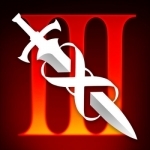
Infinity Blade III
Games and Entertainment
App
Join our new forums: https://www.epicgames.com/infinityblade/forums/ What the press is saying about...
Purple Phoenix Games (2266 KP) rated Harry Potter: Death Eaters Rising in Tabletop Games
Dec 3, 2020
Harry Potter: Death Eaters Rising is a game utilizing the Rising system of games (which also includes Batman, Star Wars, and SpongeBob Squarepants as of now) for two to four players. It is a cooperative game where players will take charge of one of the three factions: Dumbledore’s Army, Hogwarts, or Order of the Phoenix in order to defeat Voldemort and his Death Eater cronies. Though Voldemort will be menacing players throughout the game, the players will not be able to attack him directly until about half way through the game. Can you survive long enough to battle the big bad?
DISCLAIMER: We were provided a copy of this game for the purposes of this review. This is a retail copy of the game, so what you see in these photos is exactly what would be received in your box. I do not intend to cover every single rule included in the rulebook, but will describe the overall game flow and major rule set so that our readers may get a sense of how the game plays. For more in depth rules, you may purchase a copy online or from your FLGS. -T
To setup, follow the instructions in the rulebook, but generally the central board will have the large painted Voldemort “mini(?)” and three areas that hold Place cards: Hogwarts, Ministry of Magic, and Diagon Alley. Players will be given one Leader card in their chosen faction (obviously Order of the Phoenix is best) to begin the game. Set aside the damage counters, corruption gem tokens, and Spell tokens in their own piles. Shuffle the main deck of character cards, reveal and place three per Place and then insert the Voldemort card somewhere near half-way into the shuffled deck. The game may now begin.
On a player’s turn they must complete the following steps: 1. Travel to a Location, 2. Roll Voldemort Die and resolve actions, 3. Roll, assign, and resolve Wizard dice, and 4. End Turn. After taking these actions it will be the next player’s turn.
To Travel to a Location, the active player will place their faction-matching Mission token upon one of the Places on the board. This is the Place that the active player may now be able to recruit Wizards from and also attack enemies.
Once at a Location, the active player will Roll Voldemort Die and resolve actions thenceforth. The game affords players a large green Voldemort Die to be rolled. Upon the faces are sides that instruct players to turn the Voldemort mini Left or Right one Place and attack all Wizards there (including all Wizards on a player’s team if Voldemort is now in their Location). Two faces will also show the Dark Mark. When this face is rolled Voldemort does not move, but will attack all Wizards at his current Place (by placing damage counters on the card) as well as activating ALL Death Eater Dark Mark abilities. Not all Death Eaters will have Dark Mark abilities, but when they activate, they can be deadly.
Now that Voldemort has had his fun, the active player will Roll, assign, and resolve Wizard dice. Players will have in front of them faction cards that indicate how many and of which color dice to be rolled on a turn. These dice may be added to or otherwise altered as a result of recruited Wizards’ special abilities as well. Once a player takes the appropriate dice to be rolled, they must roll them and begin assigning faces to Wizards for recruitment, Death Eaters for damage, or other abilities on team cards. Recruiting more Wizards to a player’s team or damaging Death Eaters is how the game progresses because each time a card is recruited or defeated it is removed from the main board and a new card replaces it. As long as at least one die is removed from the player’s pool each time the dice are rolled the player may continue rolling to match symbols needed.
To End Turn, the active player will add any recruited Wizards to their team, discard any defeated Death Eaters, Wizards, or Places, and retrieve their Mission token to be used on the next turn.
Play continues in this fashion of taking turns through the four steps until the Voldemort card is drawn. He then comes into play as an enemy that may be attacked like normal. Players win when they defeat enough Death Eaters and Voldemort, but can lose if the players allow a Place to be completely corrupted (usually by Death Eater card abilities), allowing four Places to be corrupted, if too many Wizards have been defeated per number of players, or any player has all their Wizards defeated from their team.
Components. This game includes a lot of components of varying style and materials. The cards are all very glossy (meh) and feature headshots of the characters mostly. The board is three pieces fit together like a pizza and is great. The damage counters are little translucent red cubes, and the corruption gem tokens are also translucent gems but gray in color. The best components in the game are by far the Voldemort, well, statue and all the dice. The Voldemort piece is incredible, and pre-painted. The stance he is taking is formidable and somewhat intimidating when he’s pointing his wand right at you. The dice have been upgraded to a matte finish (as opposed to yucky polished finish) and feature some great inking. The one negative I have to say is also about the dice: I believe that the faces sometimes can be confusing because the icons are more detailed than is necessary. While some would argue that detailed dice are better than merely serviceable dice, I would much rather see a sword on a face and know it’s a sword than to look at a die face and wonder what I am looking at exactly. In any case, that’s my opinion and yours may be different. Let’s still be friends.
So overall this is a big upgrade over the Thanos version of a Rising game for several key reasons. In Thanos I always felt like every turn could lose the game for us, and Thanos seemed to gain the Infinity Stones too quickly for my taste. In this version, you know you have half a deck before you are able to even fight Voldemort, so being able to tackle his minions until then seems more surmountable. The dice have been upgraded, and the Voldemort die is wonderful and easy to read. That was an issue I had with Thanos: his die was hard to read and the colors were not distinct enough. Not a factor in this version at all. I also feel that this version has much more faction-dependency and interplay. What I mean is that an Order of the Phoenix card may require a player to also have a Dumbledore’s Army card on the team in order to unlock access to their special ability. I like that. I like a well-balanced team, though my first game saw me recruit eight Order of the Phoenix cards and one Dumbledore’s Army card. We won, but I felt bad.
So it’s no surprise that I love this game. I find it better and easier to learn/play than the Thanos version. I like the components a whole lot more. I like the interplay between the factions more. I am sad that I prefer Marvel to Harry Potter, but I do not dislike Harry Potter, let it be known. And I do enjoy this version much more. Purple Phoenix Games gives this one a triumphant 10 / 12. My wife and I truly love it and can’t wait to play it again very soon. If you are looking for a good Rising game, I certainly recommend you look at Harry Potter: Death Eaters Rising. It’s a guaranteed hit if you or a loved one is a Harry Potter fan. For sure. It’s brilliant.

Sentinels of the Multiverse
Games
App
=============================== “This is a must have addition to your digital board game...
